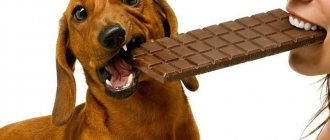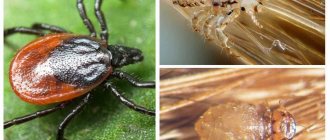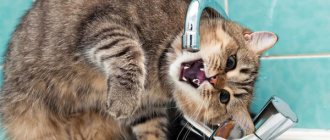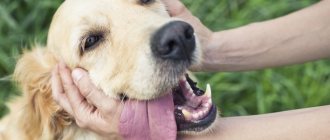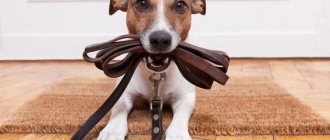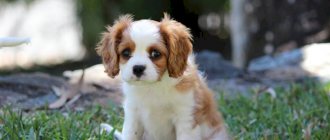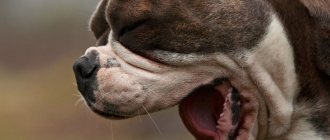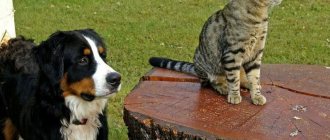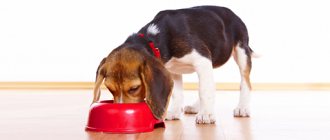Getting your dog to eat enough or stop eating so much can be a challenging situation. Obesity carries many health risks, and making sure your dog is eating properly can benefit several areas of his life. But what if your dog seems to be losing weight with a good appetite?
Sudden weight loss in dogs may signal that something is wrong, or it could simply be because they are running around more. If your dog is losing more than 10% of his total body weight, it should be cause for concern. To help you identify any potential problems, we've outlined six reasons why a dog loses weight if it has a good appetite.
Establishing the causes of thinness
Its health and longevity depend on how well an animal eats. Sometimes loving owners feed their pets and then fight excess weight. But it also happens that they suddenly notice weight loss for no noticeable reason, so they worry why the dog is losing weight.
This condition has several causes, and not all of them are related to diseases and dangerous problems. However, nutritional disorders lead to malnutrition, and therefore to a lack of beneficial vitamins, minerals, and nutrients. And this already threatens a general weakening of the body, decreased immunity and the development of many diseases.
Therefore, you need to respond to weight loss as quickly as possible and identify its cause. It may be included in the following list:
- If your dog is losing weight quickly but is eating well, this may indicate an increase in his nutritional needs. If your dog is actively growing, moving a lot and expending energy, is pregnant or nursing puppies, her usual food may not be enough to cover the increased caloric expenditure.
- When a dog has lost a lot of weight and has a good appetite, this may indicate that its food is insufficient in calories. In terms of volume, she can eat a lot, but in fact the food turns out to be “empty”.
- It is much more dangerous if the dog has become lethargic and lost weight. This condition may indicate the presence of a disease. It can be anything. A virus in the blood, a cold, diseases of the gastrointestinal tract, helminthic infestations, a foreign body in the intestines, tumors of various origins and other diseases can trigger weight loss.
- The dog often refuses food if the usual diet is changed. When switching to another food, the animal may not accept it and may not eat it at all until its regular (or favorite) food is returned to it.
- As in humans, the most common cause in dogs is a decrease in interest in food during and after illness. A sick animal may refuse to eat for several days, and this is within normal limits. It is important that the dog drinks water - dehydration, especially during illness and starvation, is extremely dangerous.
- When a dog shows a lack of interest in food when poisoned, this is a normal reaction of the body that allows it to cleanse itself of toxins. The owner’s task is to start giving food in small quantities, in pureed or crushed form, to allow the stomach to get used to the normal digestion process. In this case, you need to use only high-quality dog food.
- Weight loss can also be caused by health problems in older animals, for example, dental diseases or inflammation in the oral cavity, stomach diseases, and so on.
If the dog is cheerful and cheerful, eats well, but does not gain weight, you need to take care of its nutrition and review its composition, volume, quality and calorie level. But when weight loss leads to exhaustion, the dog’s ribs and pelvic bones and vertebrae protrude, nausea and vomiting occur, and the condition of the coat worsens—such dangerous symptoms should force the owner to show his dog to the veterinarian.
In any case, you need to entrust the treatment to a doctor and not self-medicate, so as not to harm your beloved four-legged friend.
[custom_ads_shortcode1]
Symptoms and signs of underweight
Body weight is closely related to overall well-being. A normal weight dog is active and playful. Her waist begins just behind her lower ribs and is clearly visible when viewed from above. Also, a healthy animal has a tucked belly and imperceptible, but palpable ribs. They must be covered with a small layer of subcutaneous fat.
With exhaustion or obesity, metabolism is disrupted and there is a high likelihood of developing arthritis. If you notice behavioral changes, carefully examine your pet. Depending on external symptoms, there are 4 deviations from normal weight:
- Obesity
. The dog has massive fat deposits on the chest, lower back and base of the tail. There is no waist. - Overweight
. The transition to the waist is almost lost. Fatty deposits are visible on the lower back and at the base of the tail. The ribs are difficult to palpate, as they are covered with a thick layer of fat. - Underweight
. The transition to the waist is sharply defined. The pelvic bones and lumbar vertebrae are visible. When palpating the ribs, subcutaneous fat is not felt. - Dystrophy
. Loss of muscle mass and lack of fat reserves are obvious. Protruding bones are clearly visible from the side.
In the first two cases, the dog is put on a diet and physical activity is increased. Despite popular belief, gaining pounds is much more difficult than losing it. To gain not only fat, but also muscle mass, you will have to work hard - both the owner and the dog itself.
What not to do
If a dog has suddenly lost weight, this most likely indicates the presence of internal health problems. A specialist should treat the pet, and the owners themselves need to know what under no circumstances should they do:
- Trying to give medications to an animal, especially those intended for humans, without the permission of a veterinarian.
- Forcing a dog to eat.
- Increase the calorie content of food by increasing its fat content.
- Overfeed the dog.
- Use monotonous food, for example, giving the dog only meat in large quantities or feeding it the same dry food for many years in a row.
- Feed the animal too often.
The dog's nutrition should be correlated with its age, gender and size, and energy loss. It must not only be varied within the limits acceptable for the dog (not ice cream and candies with smoked fish and sausage!), but also balanced in the content of fats, proteins and carbohydrates. We also shouldn’t forget about vitamins and minerals, which are so important for your pet’s health.
[custom_ads_shortcode2]
When to fatten a dog
If the dog has lost weight, but eats well, you need to feed it more strongly, increasing the calorie content of the food or its volume. Most often this happens after an illness or injury, and the animal quickly restores its condition. However, you need to be careful not to overfeed your dog, as this can cause indigestion.
Food should be given often and little by little, its volumes should be increased gradually, allowing the weakened body to get used to food gradually.
Before an exhibition, the question often arises of how to gain weight for a dog so that it adds a little “roundness” to its shape and looks more advantageous. During such periods, you need to increase the calorie content of food, for example, add more cereals to it, and slightly limit the animal’s activity.
This is a good way for a dog that is overly energetic and active, but you cannot completely deprive it of movement, this will have a bad effect on both health and appearance. If the dog is not gaining weight at all, you will have to completely change its menu. You need to monitor how quickly she eats her usual portion. If the food is destroyed in 5 minutes, the dog is given little food, if it takes more than 20 minutes to feed, then a lot.
Food should be balanced and selected according to the breed and age of the animal. When the owner cannot cope with such a task himself, a veterinarian will help him. Thinness can be explained by the condition of the animal. If she is a lactating female with a large number of puppies, then the pet owner should feed her according to her lactation.
A healthy adult animal is fed twice a day: morning and evening. Very large dog breeds can be fed once a day, while small lap dogs can be fed up to three times a day.
After the animal eats and moves away from the bowl, it is taken away, the remains are thrown away, and the dishes are washed and put away. Food should not be constantly in the animal’s immediate access; this disrupts the diet and disrupts proper digestion. Ideally, feed your pet at the same time - it will develop a habit. Clean drinking water should always be freely available, especially during the hot season.
By taking care of the proper and rational nutrition of his pet, the owner will not only preserve his good health, but will also make the dog beautiful, strong, and looking great.
Authors of the articles: Belanta Clinic team
A caring owner of a four-legged friend will definitely notice that for some reason the pet eating regularly and with appetite has begun to lose weight. Naturally, this will cause concern and anxiety, especially if there are no apparent reasons for this. Why does a dog lose weight with a good appetite? When is this normal and when is it a sign of illness?
[custom_ads_shortcode3]
Proper nutrition
It is known that a dog should not be fed food from the table. However, many careless owners still cannot learn this rule. Proper nutrition is the key to the health and longevity of your four-legged pet. No matter how busy you are with your daily activities, you must find time to choose complete, high-quality food for your little friend. There are many options on the market today that you can choose from. If you don’t want to buy professional food, then prepare it specifically for your dog. You need to find time for this, even sacrificing your own rest and entertainment. The food should be of high quality, as for yourself. There is no need to save money on a dog, this is a big misconception. Subsequently, treating your pet will cost much more.
The dog's weight is normal
How can you determine if your dog weighs the right amount? Of course, you can look into the standard and find out the parameters of representatives of a certain breed. But the height and gender of the animal should be taken into account, since the weight located at the upper limit will not be normal if the pet’s height is located at the lower limit. In addition, many pets do not have a breed, being mestizos or mongrels. In this case, there is no data or tables - everything is strictly individual.
In a dog of normal build, the ribs, croup bones and moslaks - the heads of the hip joints - should be palpable. Upon visual inspection, protruding bones are a sign of excessive thinness. However, it is worth considering that there are a number of breeds that are naturally thin.
Even when eating well, Salukis, Great Danes, Greyhounds, Italian Greyhounds and others remain slim and lean. And this is considered normal. There are also dogs of the same breed, but with different builds, for example, there are shepherd dogs that are tightly built, and there are “dry” ones.
Of course, it is easier for owners of a short-haired pet to notice that their pet has lost weight. Whereas long-haired individuals retain their appearance for a long time, regardless of body weight. But if weight loss is associated with a pathological process, then the animal will certainly show accompanying signs:
- deterioration in the quality of wool - it loses its shine, becomes faded, dry, thinned, and may fall out profusely;
- change in behavior - the pet is lethargic, irritable, does not show interest in others, is more often in a lying position, does not participate in games, and even a call to go for a walk does not evoke positive emotions in him;
- vomiting, diarrhea occurs;
- increase or decrease in body temperature;
- tremor;
- breathing disorder.
Some serious illnesses can provoke aggression and inappropriate behavior. In this case, even emergency delivery of the dog to the clinic does not guarantee a good outcome.
[custom_ads_shortcode1]
Temperature measurement
Dogs have their temperature measured in the rectum. You will need an assistant to hold the dog still. Or place the dog on its side. Take a medical thermometer and lubricate the end with Vaseline, baby cream, and oil. Using rotational movements, insert the thermometer into the rectum approximately 1.5 cm. Hold for 2-3 minutes.
Normal body temperature is between 37.5 and 39.5 degrees, with small breeds and puppies having a higher temperature than large breeds and adults. An increased level may indicate an infectious disease; a decreased level is observed due to hypothermia, shock, or before childbirth.
Gastrointestinal diseases
Normally, the dog's stomach remains soft if you gently press on it. If the abdominal muscles tense when touched, this may be a sign of illness. This is observed with inflammation of the stomach, the presence of a foreign object in this organ, ulcerative damage to the walls, intestinal blockage and other pathologies of the gastrointestinal tract.
With diseases of the gastrointestinal tract, the dog develops diarrhea, he becomes lethargic, apathetic, and suffers from vomiting. If any of the symptoms occur, it is recommended to measure the pet’s temperature and assess the condition of the mucous membranes - their blue or yellow discoloration is a serious symptom of the disease.
Almost any disease associated with disruption of the gastrointestinal tract is accompanied by pain of a different nature. You can usually tell that a pet is in pain by its reactions. If the dog is trembling, irritated, acting cautiously, and his breathing is shallow, we are talking about severe pain. In this case, the dog, when standing, begins to hunch his back, and his steps are small, without scope.
[custom_ads_shortcode3]
Allergic reactions
Food allergies are another reason why your dog eats and loses weight. With this pathology, the animal’s body begins to function in emergency mode, which leads to increased energy consumption and a decrease in body weight. This condition is accompanied by certain signs: the dog begins to actively itch, the flow from the eyes and nose intensifies, and the appetite worsens. Irritated areas may appear on the skin, and hair may fall out in places.
If during the initial examination it was not possible to detect parasites that can cause such symptoms, you should give your pet an antihistamine. If the symptoms begin to subside, then it is still an allergy problem.
[custom_ads_shortcode2]
Worm infestations
Worms are frequent guests of the dog’s body, eating what is intended for the normal functioning of the animal’s organs and systems. In this case, the dog eats with increased appetite, but important substances are provided not by it, but by its “neighbors.”
There is a schedule for deworming dogs, according to which pets are given anthelmintic drugs, usually this event is carried out once every 3-4 months. If you follow this rule, the helminths that have entered the body will not have time to actively multiply and cause serious harm.
If the owner forgets about the procedure or ignores it completely, the worms can spread throughout all systems, consuming vital components before they are digested and absorbed into the intestines. Some of the worms can seriously damage the tissues of the liver, lungs, heart and even brain. And if this happens, you can expect serious changes, including metabolic disorders.
In such a situation, the pet sharply loses weight, lacks vitamin components and microelements, and organ failure develops. Such conditions often lead to irreversible consequences and death of the dog.
Contacting a veterinarian will help save your pet’s life, but the consequences of helminthic infestation can subsequently cause various complications and periodically remind themselves. So it is better to take care of prevention; this will not 100% protect the dog from worms, but it will reduce the likelihood of them staying comfortably in the pet’s body.
[custom_ads_shortcode3]
Veterinary examination
It is necessary in order to exclude any pathologies in the body. A full veterinary examination is not very cheap. But it allows you to understand the state of your pet’s health.
If it has been noticed that the dog is losing weight for no good reason, a full diagnosis needs to be carried out. Only in this case will it be possible to understand the situation. Without an examination, nothing can be determined. Old animals lose weight, despite proper care and timely intake of special supplements. Dogs are very sensitive to various changes in their health. The more attention they receive, the better.
Postoperative recovery
Any surgical intervention, even minimally invasive, is stressful for the animal’s body, and weight loss during this period is considered normal. But, of course, we are not talking about critical weight loss, when only “skin and bones” remain from a well-fed pet.
Unfortunately, four-legged friends tolerate anesthesia worse than humans. This applies even to physically strong, young animals, but they have enough internal reserves to recover. Much depends on how complex the operation turned out to be, and during this period it is important that the pet is monitored by a specialist.
If a dog is losing more weight than expected, an experienced doctor will definitely pay attention to this fact. If he does not consider this sign dangerous, it is worth consulting with another veterinarian.
[custom_ads_shortcode1]
Viral infections
Viruses are very dangerous for dogs, regardless of the age and breed of the animal. The risk group includes puppies and older dogs. A sharp decrease in body weight can be caused by any viral pathogen, but vaccination can protect against some of them:
- rabies - the disease is dangerous for humans, but fatal for dogs;
- carnivore plague - can be cured only at an early stage of development;
- enteritis – even vaccination will not protect your pet 100%, but will help avoid acute manifestations of the disease;
- adenovirus – rarely detected, requires serious, long-term treatment;
- leptospirosis - the disease is dangerous for people, treatable, rarely diagnosed;
- piroplasmosis – with the help of a vaccine it is possible to avoid acute manifestations of the disease.
[custom_ads_shortcode2]
Oncological processes
Malignant formations and metastases also lead to a sharp weight loss in the animal. The danger lies in the fact that in most cases it is possible to identify the disease only in the later stages. The initial stages of cancer are latent, without pronounced symptoms, so they are often discovered during diagnostics not related to oncology.
Late stage cancer is not curable, but stops. The animal is prescribed a course of chemotherapy or radiation therapy. These methods are quite harsh, they harm not only malignant cells, but also healthy ones, so the dog loses weight and feels unwell, both during treatment and after it. With the help of competent restorative therapy, it is possible to restore the dog’s strength and appetite.
[custom_ads_shortcode3]
Degradation of drinkers
Treatment of the last stage of alcoholism is cured slowly and requires enormous effort on the part of the drinker. By this point, the patient becomes hot-tempered and behaves inappropriately. His memory is deteriorating.
As brain cells die, dementia develops. Such a person no longer lives, but rather parasitizes at the expense of his relatives. It is important to motivate him to recover. If an addict has a complete lack of desire to be treated, even the best narcologist in the world will not be able to help him.
Do not allow alcoholism to progress. If you realize that you cannot stop or one of your loved ones suffers from daily drinking, be sure to get qualified drug treatment help. By doing so, you will give yourself or your loved one a chance to become completely healthy. But even at the third stage of the disease, do not give up on the patient - everything can still be corrected.
Incorrect feeding regimen and diet
Any veterinarian who did not identify pathologies during diagnosis will be interested in what the owner feeds his pet. It's not uncommon for a dog to lose weight by not eating a balanced diet or sticking to a schedule. What should an owner pay attention to when feeding a four-legged friend?
- Variety should be moderate . With natural feeding, you should not give your dog everything, trying to keep his menu varied. In fact, a balanced diet for these animals consists of 5-6 products, and the list of prohibited foods is quite long. But if your dog consumes only 1-2 products, it is worth reviewing its diet and including a few more components in it.
- It is worth taking a more careful approach to the selection of food . Low-price products consist of cereals with a small content of meat processing waste. Naturally, such food cannot be called suitable for a dog, since most of the ingredients are not absorbed by the dog’s body. In this case, even increasing the portion will not help your pet gain weight. The food must be of high quality, consisting of meat components, vegetables, a small amount of cereals, and vitamin and mineral supplements. Premium and super-premium brands meet similar requirements. It is recommended to periodically give your pet canned food to diversify your pet's diet. It is advisable that it be of the same brand as the main one.
- It is important to take care of your pet's access to water . If during natural feeding the animal receives part of the moisture from food, then when eating “drying” it comes mainly from a separate bowl. The owner must remove the remains of uneaten food, but this does not apply to water - it must always be in the bowl so that the dog can drink at any time. Otherwise, the animal may experience dehydration, which may result in vomiting, regurgitation of dry, undigested granules, difficulty defecating, etc.
Losing weight in a pet is an alarming sign, especially if its appetite does not deteriorate. The owner should take a closer look at the behavior of his four-legged friend, and for his own peace of mind, take him to the veterinarian.
Sources:
- ivethelp.ru
- www.belanta.vet
- dogipedia.ru
How and what to feed a losing weight dog
A dog that has lost significant weight is gradually returned to a normal diet, first by slightly limiting the animal’s activity. In this case, the following rules are adhered to:
- if the dog eats natural products, then the diet must include porridge and light soups;
It is recommended to flavor raw vegetables with vegetable oil or low-fat sour cream - this promotes better absorption of vitamins;- even an animal on dry food should be periodically given raw meat (excluding lamb and pork), but it must first be doused with boiling water to avoid infection with helminths;
- Boiled fish fillets are added to the menu 1-2 times a week.
To pamper your pet with a treat, give him a “sugar” bone to chew on as a snack. But foods high in carbohydrates (baked goods, sweets), spices, flavorings, smoked foods and fried foods should be excluded completely.
Milk is only good for babies; adult dogs have a low lactose tolerance.
